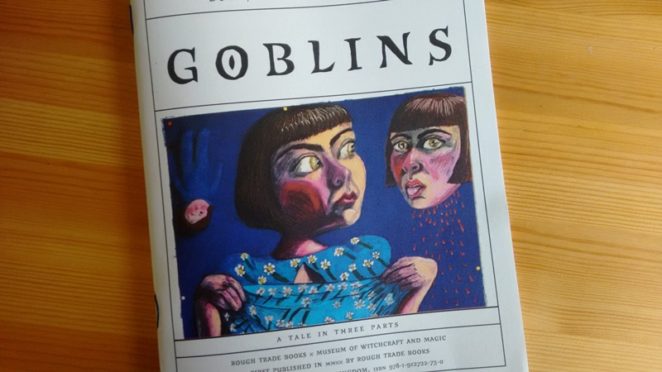Blog
Goblins by Jen Calleja – a few thoughts
Full disclosure: I’ve known Jen for a good few years. We’ve interviewed each other, worked together and gossiped over Korean food. This is probably not an impartial review, if a review is what this is. Hey ho.

I knew I had to have Goblins as soon as it was out, being a fan of Jen and Rough Trade and the Museum of Witchcraft and Magic in Boscastle. What a combination of contributing energies. Jen immediately goes deep into her own childhood, working from the pamphlet’s central idea that a goblin has no shame. There are slightly inappropriate puppets and the facts of a pupating, little-girl body. There’s compassion there directed towards creatures in fairy-tales that we are supposed to see as ugly, foreign and transgressive, and what’s even more excellent (and the whole point) – compassion towards those exact parts of herself, and of people close to her.
The pamphlet’s themes are many and varied, but perhaps unsurprisingly it’s translation that caught my eye. Jen’s views on it are also refracted via puppetry, but the analogy isn’t a stretch at all: “Translators are like ventriloquists, but we’re also the ventriloquist’s dummy. We do the voices, but our every move is guided by the texts we translate. Can you tell it’s our voice every time?” I’ve been asking myself a question along these lines. It’s not even “translationese” I’ve been worrying about sometimes; it’s “Dziuroszese”, my idiolect, my personality, the books I’ve read and the books I want to write, the cadences of my favourite lyricists – can my translations transcend that? Do I want them to?
The little goblin girl grows up and starts encountering male, powerful goblin kings, those who would lure and displace her. The interplay between rejecting that lure and allowing yourself to be hooked by it is something I remember from my own goblin teenagerdom: “you can’t tell whether you’re bewitching them or they’re bewitching you”. Later, Jen’s references move from children’s (?) entertainment to gobliny art; the third and last section, Goblincore, focuses on music. Here her own experiences as a maker and performer give the writing a particularly lived and meaty quality, and the moment when she goes past focusing on her own perception of how others perceive her, and lands squarely in pure experience and self-possession, is triumphant.
I feel like there are two impulses to the pamphlet: one is a jaunty jab to the side, a reminder to do your thing and move with freedom; the other is that, just like in fairy-tales, it’s important to be able to tell the difference between creatures who are truly evil, and those who have just had a tough time, those who pretend to subvert and those who really do. The pamphlet is excellent on what might broadly be termed justice: being clear-eyed and unafraid to see things for what they are. It is crisp, mischievous, companionable, with the slight bitter aftertaste of truth. You’ll want to down it again and again, for courage.
Goblins by Jen Calleja, with brilliant illustrations by Rachel Louise Hodgson
Rough Trade Books x Museum of Witchcraft and Magic, 2020




